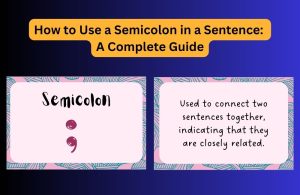This article covers the following areas –
- What is a Run-On Sentence?
- Why Run-On Sentences are Problematic?
- How to Spot Run-On Sentences?
- How to Fix Run-On Sentences?
- When Are Run-On Sentences Acceptable?
- Final Words
As a passionate writer, I’ve often encountered the common pitfall of run-on sentences. They can be tricky, sneaking into our writing and disrupting the clarity and flow. In this article, I’ll share my insights on identifying and correcting run-on sentences, drawing from my experience and extensive reading.
Run-on sentences occur when two or more independent clauses are improperly connected without adequate punctuation or conjunction. They can be spotted by their length, lack of proper punctuation, and by reading aloud for natural pauses. To fix them, use periods, commas with conjunctions, or semicolons.
Continue reading for comprehensive guidelines on identifying and correcting run-on sentences, including detailed examples and tips. This will enhance your understanding and ability to write clear, effective sentences.
What is a Run-On Sentence?
A run-on sentence occurs when two or more independent clauses (clauses that can stand alone as separate sentences) are connected improperly. For example:
- Incorrect: I love writing it is my passion.
- Corrected: I love writing. It is my passion.
In the incorrect example, two independent clauses are merged without proper punctuation or conjunction, making it a run-on sentence.
Why Run-On Sentences are Problematic?
Imagine you’re listening to someone who talks really fast, without pausing. It’s hard to follow, right? Run-on sentences are like that in writing. They pack too much information without a break, making it tough for the reader to catch their breath and understand each point clearly.
Here’s an Example:
- Run-On: We went to the zoo it was a sunny day the lions were sleeping the monkeys were playing.
- Why It’s Problematic: This sentence throws a lot of information at you all at once. It’s like trying to watch four different TV shows on the same screen at the same time – confusing!
Now, let’s break it down to make it clearer:
- Corrected: We went to the zoo. It was a sunny day. The lions were sleeping. The monkeys were playing.
- Why It’s Better: Each sentence now gets its own spotlight. You can picture each scene: the zoo trip, the sunny weather, sleepy lions, and playful monkeys. It’s like watching one TV show at a time, so you can really enjoy and understand each part.
Another Example:
- Run-On: I like to read books I also enjoy writing stories sometimes I draw.
- Why It’s Problematic: This sentence jumbles up three different hobbies without giving each its due space. It’s like mixing up the ingredients of three different recipes in one bowl – a bit messy!
- Corrected: I like to read books. I also enjoy writing stories. Sometimes I draw.
- Why It’s Better: Now, each hobby is given its own sentence. It’s like having three neat, separate bowls for each recipe, making it clear and easy to follow.
So, run-on sentences can make your writing hard to digest because they cram too many ideas together without clear breaks. Using proper punctuation to give each idea its own space makes your writing much easier to understand. Think of it like organizing a messy room: everything looks better and makes more sense when it’s properly placed.
How to Spot Run-On Sentences?
Run-on sentences can sneak into our writing, creating confusion and muddling our message. Spotting them isn’t always straightforward, but you can become a pro at catching these pesky sentence structure issues with a few key strategies. Here’s how to identify run-on sentences, ensuring your writing remains clear and effective.
1. Consider Too Long Sentences as a Clue
Long sentences aren’t always run-ons, but if a sentence rambles on for too long, it’s time to take a closer look. An excessively long sentence might be trying to do too much, jamming several complete thoughts together without proper breaks.
Example: I went to the market I bought apples, oranges, and bananas.
- Why It’s a Run-On: This sentence tries to say too much at once. It needs a break to separate the ideas.
- Correction: I went to the market. I bought apples, oranges, and bananas.
Tips for Analysis:
- Break It Down: Look for natural pauses where sentences could end. If you find multiple complete thoughts (independent clauses) in one long sentence, it might be a run-on.
- Check for Complexity: Complex sentences with lots of commas and clauses can sometimes hide run-ons. Try simplifying the sentence to see if it’s actually combining separate ideas.
2. Look Out for Missing Punctuation
Run-on sentences often forget to invite punctuation to the party. Punctuation marks like commas, semicolons, or periods are essential for separating independent clauses.
Example: She loves gardening it’s her favorite hobby.
- Why It’s a Run-On: There’s no punctuation separating the two complete thoughts.
- Correction: She loves gardening; it’s her favorite hobby. or She loves gardening, as it’s her favorite hobby.
What to Look For:
- Missing Commas: When two independent clauses are joined by conjunctions (like ‘and’, ‘but’, ‘or’), they usually need a comma before the conjunction.
- Semicolons: Sometimes, two related independent clauses are connected without a semicolon, which can lead to run-ons.
3. Use The Power of Hearing by Reading Aloud
Reading your sentences out loud is a surprisingly effective way to spot run-ons. It helps you hear the natural rhythm of your writing and identify where pauses should be.
Example: The sun was setting the sky turned a brilliant orange.
- Why It’s a Run-On: When you read it out loud, it sounds rushed and crammed together.
- Correction: The sun was setting. The sky turned a brilliant orange.
How to Do It:
- Take a Breath: If you’re running out of breath while reading a sentence, it’s a sign that the sentence might be too long or a run-on.
- Listen for Confusion: If a sentence sounds jumbled or confusing when read aloud, it might need to be broken down into smaller, clearer parts.
4. Look for Conjunctions
Conjunctions like ‘and’, ‘but’, or ‘so’ are great for linking ideas, but they can contribute to run-ons if used without proper punctuation.
Example: He ran fast but he missed the bus.
- Why It’s a Run-On: There’s no comma before the conjunction ‘but’.
- Correction: He ran fast, but he missed the bus.
Checking for Conjunction Misuse:
- Comma Before Conjunctions: When connecting two independent clauses with a conjunction, look for a comma before the conjunction.
- Conjunction Repetition: Repeated use of conjunctions in a long sentence might be a sign of a run-on.
You can become adept at spotting run-on sentences by paying attention to these aspects – length and structure, punctuation, reading aloud, and conjunction use. Remember, clear and concise writing conveys your message effectively and enhances your content’s overall readability. Keep these tips in mind, and you’ll be on your way to cleaner, clearer writing in no time.
How to Fix Run-On Sentences?
Run-on sentences can make your writing hard to follow and understand. Fortunately, there are several straightforward ways to fix them, ensuring your sentences are clear and effective. Let’s explore these methods with examples and tips to help you enhance your writing.
1. Use a Period to Split Sentences for Clarity
The simplest and most direct way to correct a run-on sentence is by using a period. This technique is effective when you have two independent ideas that can stand alone as separate sentences.
Example: The garden is beautiful many flowers are blooming.
- Why It’s a Run-On: It combines two complete thoughts without proper punctuation.
- Correction: The garden is beautiful. Many flowers are blooming.
Applying This Fixing Method:
- Identify Separate Ideas: Look for distinct thoughts that can stand alone.
- Use Periods: Insert a period to divide these thoughts into separate sentences.
2. Employ a Comma & a Conjunction to Connect Related Clauses
Sometimes, the ideas in your sentence are closely related and can be connected smoothly with a comma and a conjunction. This method keeps the sentence flowing and maintains the connection between the ideas.
Example: He enjoys hiking he doesn’t like camping.
- Why It’s a Run-On: Two independent clauses are joined without a comma or conjunction.
- Correction: He enjoys hiking, but he doesn’t like camping.
How to Correctly Use This Technique:
- Find Closely Related Clauses: Ensure the clauses are connected in meaning.
- Insert Comma and Conjunction: Place a comma before the conjunction (like ‘and’, ‘but’, or ‘or’) to link the clauses.
3. Utilize a Semicolon to Link Independent Clauses
When two independent clauses are closely related but can stand alone, a semicolon can be a graceful solution. It provides a stronger link than a period without the need for a conjunction.
Example: She is an excellent cook she never follows recipes.
- Why It’s a Run-On: Two complete ideas are merged without proper punctuation.
- Correction: She is an excellent cook; she never follows recipes.
Implementing Semicolons:
- Determine if Clauses are Independent: Check if each part can stand alone.
- Use a Semicolon: A semicolon can connect these clauses while showing they are part of one larger thought.
By employing these methods – using periods, combining with commas and conjunctions, and utilizing semicolons – you can effectively fix run-on sentences in your writing. This not only improves readability but also enhances the overall quality of your work. Remember, clear and concise sentences are key to effective communication in writing.
When Are Run-On Sentences Acceptable?
Run-on sentences typically earn a red mark in most writing scenarios, but there’s a unique exception in the realm of creative writing. Here, bending the rules of grammar, including the use of run-on sentences, can be a powerful tool to convey a specific mood, rhythm, or voice.
1. While Setting a Mood or Tone in Creative Writing
In literature, especially in prose or poetry, run-on sentences can effectively mirror a character’s state of mind or the intensity of a situation. A long, uninterrupted sentence might represent a stream of consciousness, a rush of emotions, or a moment of chaos.
Example: He ran through the streets, past the markets, the noise blending with his thoughts, his heart racing, his feet barely touching the cobblestones, the city a blur, a canvas of light and shadows.
- Why It Works: This run-on sentence captures the character’s frantic pace and overwhelmed senses, creating an immersive experience for the reader.
2. While Conveying Rhythm and Flow
Run-on sentences can also be used to create a specific rhythm in the narrative. By deliberately avoiding the usual stops and pauses that periods or commas provide, a writer can give the text a unique flow, often emulating natural speech or thought.
Example: In the early morning light everything seemed fresh and full of possibility, the world awakening, birds singing, a gentle breeze whispering through the leaves.
- Why It Works: The continuous flow of the sentence mimics the seamless transition from night to day, enhancing the peaceful and hopeful atmosphere.
3. While Reflecting a Character’s Voice
Characters in a story might have their distinct ways of speaking or thinking, which can be represented through run-on sentences. This can particularly be effective in first-person narratives or direct dialogues.
Example: I can’t believe it’s already over, time just flew, feels like yesterday we were kids playing in the yard, and now here we are adults, where did all those years go.
- Why It Works: The run-on sentence reflects the character’s nostalgic, rambling thoughts, giving insight into their emotional state.
Final Words
While run-on sentences can be a powerful stylistic device in creative writing, they should be used intentionally and judiciously. Overuse can lead to confusion and may disrupt the reader’s engagement. The key is ensuring that the run-on sentences enhance the narrative’s effectiveness rather than detract from the narrative’s effectiveness.
Run-on sentences can add depth and character to your creative writing when used with clear intent and purpose. They allow for experimentation with the rhythm and flow of language, helping to convey emotions and thoughts in a way that traditional sentence structures might not. However, it’s crucial to strike a balance to maintain readability and impact.
Identifying and fixing run-on sentences is crucial for clear, effective writing. By understanding what they are, learning how to spot them, and practicing correction methods, you can enhance the readability and professionalism of your writing. Always remember, writing is an art, and mastering sentence structure is a key part of that artistry.
Remember, writing is a journey of continuous learning and improvement. Run-on sentences might be a small part of the vast language landscape, but mastering them can significantly elevate the quality of your writing. Keep practicing, keep learning, and most importantly, keep writing!






